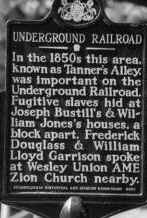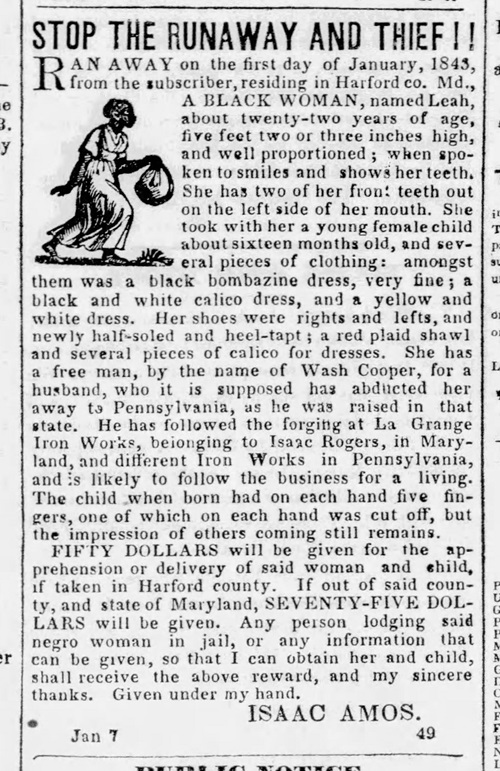
Study Areas
Anti-Slavery
January 1843: A Family Escapes in Winter

STOP THE RUNAWAY AND THIEF!!
RAN AWAY on the first day of January, 1843, from the subscriber, residing in Harford co. Md., A BLACK WOMAN, named Leah, about twenty-two years of age, five feet two or three inches high, and well proportioned; when spoken to smiles and shows her teeth. She has two of her front teeth out on the left side of her mouth. She took with her a young female child about sixteen months old, and several pieces of clothing: amongst them was a black bombazine dress, very fine; a black and white calico dress, and a yellow and white dress. Her shoes were rights and lefts, and newly half-soled and heel-tapt; a red plaid shawl and several pieces of calico for dresses.
She has a free man, by the name of Wash Cooper, for a husband, who it is supposed has abducted her away to Pennsylvania, as he was raised in that state. He has followed the forging at La Grange Iron Works, belonging to Isaac Rogers, in Maryland, and different Iron Works in Pennsylvania, and is likely to follow the business for a living.
The child when born had on each hand five fingers, one of which on each hand was cut off, but the impression of others coming still remains.
FIFTY DOLLARS will be given for the apprehension or delivery of said woman and child, if taken in Harford county. If out of said county, and state of Maryland, SEVENTY-FIVE DOLLARS will be given. Any person lodging said negro woman in jail, or any information that can be given, so that I can obtain her and child, shall receive the above reward, and my sincere thanks. Given under my hand.
ISAAC AMOS.
Jan 7
Notes
The advertisement above is rich in details. Leah, a young Black woman, left the estate of Isaac Amos in Harford County, Maryland with her sixteen-month-old daughter on New Years Day 1843. With them was Wash Cooper, a free Black ironworker from Pennsylvania who had worked at the La Grange Iron Works, near Deer Creek in Harford County. The Amos family estate was nearby.
The La Grange Iron Works were established in the 1830s and acquired by Isaac Rogers and his son Joseph McClellan Rogers, Quakers from Chester County, in 1834. Isaac's son Evans Stanley Rogers married a great-granddaughter of Michael Ege, the iron magnate of Boiling Springs, Cumberland County, Pennsylvania. Wash Cooper, as a free Black man who "followed the forging" in both Maryland and Pennsylvania, was probablhy very familiar with the mountain routes connecting the various forges that dotted the rural landscape up through central Pennsylvania. These forges all employed numerous free and enslaved Blacks in their histories, with nearly all African Americans working in the Pennsylvania forges being free persons by this time. These forges represented an established trail to liberty for southern freedom seekers and Wash Cooper likely had contacts at most forges along the way.
Leah's infant daughter, who is not named, was born with an extra finger on each hand. Someone apparently cut off the extra finger from each hand, and the advertisement notes: "the impression of others coming still remains," indicating either scars, or tiny undeveloped additional fingers.
Note that the family escaped on New Year's Day. This was probably a holiday for the Amos family, with reduced work and responsibilities for their enslaved workers. There was, perhaps, a larger window of time in which the family's escape would go unnoticed, allowing more time on the road. It was, however, still early in winter. The description of Leah's clothing does not include outer garments to guard against the cold. It is interesting to note that she took extra calico cloth to make more clothing, and that the pair of shoes she wore were made made for left and right feet, an innovation which was not yet common, most shoes still being "straights" designed to be worn on either foot.
Sources
Lancaster Intelligencer and Journal, 24 January 1843
Maryland Historical Trust, "La Grange House and Outbuildings," Architectural Survey File, 04 February 2016.
 Covering
the history of African Americans in central Pennsylvania from the colonial era through the Civil
War.
Covering
the history of African Americans in central Pennsylvania from the colonial era through the Civil
War.
Support the Afrolumens Project. Read the books:
The Year of Jubilee, Volume One: Men of God, Volume Two: Men of Muscle

